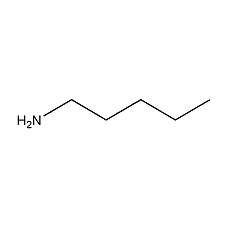
Structural formula
| Business number | 031H |
|---|---|
| Molecular formula | C5H13N |
| Molecular weight | 87.16 |
| label |
n-pentylamine, 1-Aminopentane, 1-Pentylamine, 1-Aminopentan, 1-Pentanamine, n-Amylamine, 1-Pentylamine, Pentylamine, emulsifier, anti-corrosion agents, flotation agent, rubber vulcanization accelerator, Antioxidants |
Numbering system
CAS number:110-58-7
MDL number:MFCD00008236
EINECS number:203-780-2
RTECS number:SC0300000
BRN number:505953
PubChem number:24850059
Physical property data
1. Properties: colorless liquid with pungent odor. [1]
2. Melting point (℃): -55[2]
3. Boiling point (℃): 104.5[3]
4. Relative density (water = 1): 0.76[4]
5. Relative vapor Density (air=1): 3.0[5]
6. Saturated vapor pressure (kPa): 4.65 (26℃)[6]
7. Heat of combustion (kJ/mol): -3621.5[7]
8. Critical temperature (℃): 281.6[8]
9. Critical pressure (MPa): 3.58[9]
10. Octanol/water partition coefficient: 1.05~1.49[10]
11. Flash point (℃): -1 (CC); 7.2 (OC) [11]
12. Ignition temperature (℃): 302[12]
13. Explosion upper limit (%): 9.5[13]
14. Lower explosion limit (%): 1.3[14]
15. Solubility: soluble in water, ethanol, and ether. [15]
16. Refractive index (20ºC): 1.448
17. Viscosity (mPa·s, 20ºC): 1.018
18. Heat of evaporation (KJ/kg): 452.1
19. Specific heat capacity (KJ/(kg·K), 25ºC, constant pressure): 2.72
20. Body expansion Coefficient (K-1, 20~60ºC): 0.00116
Toxicological data
1. Acute toxicity: rat abdominal LDLO: 37500ug/kg; rat oral LD50: 470mg/kg.
2. It irritates the skin and mucous membranes and can be absorbed by the skin. Direct contact with the skin can cause 1 to 2 degree burns.
3. Acute toxicity [16] LD50: 470mg/kg (rat oral)
Ecological data
1. Ecotoxicity No data available
2. Biodegradability No data available
3 .Non-biodegradability No information available
4. Other harmful effects[17] This substance is harmful to the environment and should be treated with special Pay attention to water pollution.
Molecular structure data
1. Molar refractive index: 28.74
2. Molar volume (cm3/mol): 114.7
3. Isotonic specific volume (90.2K ): 260.1
4. Surface tension (dyne/cm): 26.4
5. Polarizability (10-24cm3): 11.39
Compute chemical data
1. Reference value for hydrophobic parameter calculation (XlogP): None
2. Number of hydrogen bond donors: 1
3. Number of hydrogen bond acceptors: 1
4. Number of rotatable chemical bonds: 3
5. Number of tautomers: none
6. Topological molecule polar surface area 26
7. Number of heavy atoms: 6
8. Surface charge: 0
9. Complexity: 19.9
10. Number of isotope atoms: 0
11. Determine the number of atomic stereocenters: 0
12. Uncertain number of atomic stereocenters: 0
13. Determine the number of chemical bond stereocenters: 0
14. Number of uncertain chemical bond stereocenters: 0
15. Number of covalent bond units: 1
Properties and stability
1. It has the chemical reaction properties of primary amines, and its aqueous solution is alkaline. It is unstable to oxidants and can be decomposed by hydrogen peroxide aqueous solution in the presence of activated carbon. During photolysis, in addition to a small amount of butane, methane and ammonia, a large amount of hydrogen and polymer substances are generated. Pentylamine is heated to 400°C with a chromium-alumina catalyst to generate hydrogen cyanide, ammonia, hydrogen, acetonitrile, pentyl isonitrile, saturated hydrocarbons and unsaturated hydrocarbons.
2. Stability[18] Stable
3. Incompatible substances[19] Acids, acid anhydrides, strong reducing agents
4. Polymerization hazards[20] No polymerization
5. Decomposition products[21] Ammonia
Storage method
Storage Precautions[22] Stored in a cool, ventilated warehouse. Keep away from fire and heat sources. The storage temperature should not exceed 37°C. Keep container tightly sealed. It should be stored separately from reducing agents, acids, etc., and avoid mixed storage. Use explosion-proof lighting and ventilation facilities. It is prohibited to use mechanical equipment and tools that are prone to sparks. The storage area should be equipped with emergency release equipment and suitable containment materials.
Synthesis method
React sodium azide and hexanoic acid in the presence of a catalyst. After neutralization with alkali, steam distillation, the distillate is extracted with diethyl ether, and the extract is distilled and refined to obtain the product.
Refining method: Pentylamine is prepared by the reaction of pentyl chloride and liquid ammonia, or the ammonolysis of the alcohol solution of pentyl chloride. The main impurities include dipylamine, tripentylamine, etc. It is generally refined by dehydrating metallic sodium and then fractionating it.
Purpose
1. Used as a solvent for the preparation of antioxidants, emulsifiers, pesticides, rubber chemicals, flotation agents, and also as chemical synthesis intermediates. [23]

 微信扫一扫打赏
微信扫一扫打赏

